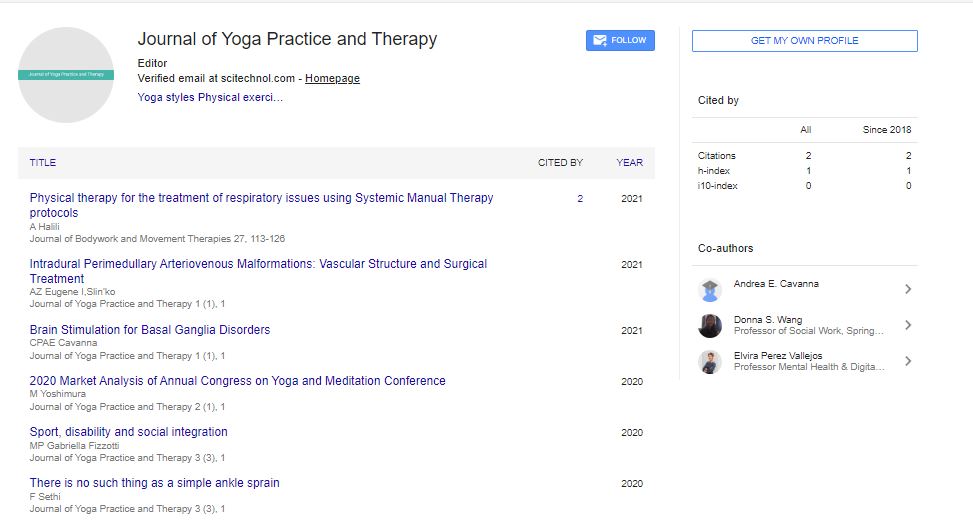Opinion Article, J Yoga Therap Vol: 6 Issue: 4
Embrace the Flow: Yoga Practice and Therapeutic Fluidity
Shubham Varambally*
1Department of Psychiatry, National Institute of Mental Health and Neurosciences (NIMHANS), Bangalore, India
*Corresponding Author: Shubham Varambally,
Department of Psychiatry,
National Institute of Mental Health and Neurosciences (NIMHANS), Bangalore,
India
E-mail: suvarambally@gmail.com
Received date: 24 November, 2023, Manuscript No. JYPTY-24-124122;
Editor assigned date: 28 November, 2023, Pre-QC No. JYPTY-24-124122 (PQ);
Reviewed date: 14 December, 2023, QC No. JYPTY-24-124122;
Revised date: 21 December, 2023, Manuscript No. JYPTY-24-124122 (R);
Published date: 28 December, 2023, DOI: 10.4172/JYPTY.1000135
Citation: Varambally S (2023) Embrace the Flow: Yoga Practice and Therapeutic Fluidity. Int J Yoga Therap 6:4.
Description
In the ever-changing currents of life, the practice of yoga emerges as a transformative journey-an invitation to embrace the flow of existence. This manuscript explores the profound relationship between yoga practice and therapeutic fluidity, delving into the ways in which the principles of fluid movement, mindfulness, and breath intertwine to create a holistic approach to well-being.
The fluidity of asanas
Dynamic yoga sequences: Embracing the flow in yoga involves dynamic sequences of asanas that mimic the rhythmic undulations of life. From the graceful movements of Vinyasa to the continuous transitions in a Yoga Flow class, these sequences encourage practitioners to connect breath with movement, fostering a sense of fluidity in both body and mind.
Moving meditation: Yoga asanas become a moving meditation, inviting practitioners to be fully present in each moment. The therapeutic aspect lies in the fluidity of movement, promoting a deep connection between breath and motion that transcends the physical postures. In this flow, the mind finds a sanctuary, and the body becomes an instrument for self-expression.
The breath as the river of life
Pranayama: The breath, like a flowing river, is integral to the therapeutic essence of yoga. Pranayama, the practice of breath control, invites individuals to navigate the currents of their own breath. Techniques such as Ujjayi breathing bring a sense of calm and focus, akin to riding the gentle waves of a serene river.
Breath awareness in asanas: The fluidity of yoga extends to conscious breath awareness during asanas. By synchronizing breath with movement, practitioners create a seamless dance where each inhale and exhale guides the ebb and flow of the practice. This mindful breathing not only enhances the therapeutic benefits of the poses but also deepens the connection to the present moment.
The therapeutic flow of mindfulness
Mindful presence: Embracing the flow in yoga is an invitation to cultivate mindful presence. As practitioners move through each pose, the therapeutic aspect lies in the attention given to sensations, thoughts, and emotions. Mindfulness becomes the current that carries individuals into a state of heightened awareness, fostering a deep sense of tranquility.
Release and let go: Fluidity in yoga involves surrendering to the present moment, allowing for the release of tension and resistance. This therapeutic release occurs both on a physical and emotional level, as practitioners learn to let go of accumulated stress, tightness, and mental clutter, creating space for a more fluid and harmonious existence.
Yoga as a therapeutic journey
Healing through movement: The therapeutic nature of yoga lies in its ability to be a healing journey. The fluidity of movement promotes circulation, flexibility, and the release of physical and emotional blockages. In this journey, practitioners navigate the currents of their own bodies, allowing the innate intelligence within to guide the way toward balance and restoration.
Adaptable to individual needs: Yoga's therapeutic fluidity makes it accessible to individuals of all ages and abilities. Whether adapting poses for physical limitations or modifying sequences for varying energy levels, the practice accommodates the unique flow of each individual's journey toward well-being.
Conclusion
In the sanctuary of the yoga mat, individuals learn to embrace the flow-a practice that extends far beyond the physical postures. The fluidity cultivated in yoga becomes a metaphor for navigating the ever-changing currents of life. As practitioners embrace the flow, they discover a profound therapeutic journey that extends into their daily existence.
Beyond the mat, the principles of therapeutic fluidity in yoga become a guide for living with grace and resilience. By integrating the seamless dance of breath, movement, and mindfulness, individuals embark on a lifelong journey of self-discovery, healing, and the art of embracing the ever-changing, ever-flowing river of life. In the embrace of the flow, yoga becomes not just a practice but a way of being-an exploration of the therapeutic beauty that arises when one learns to dance with the rhythm.
 Spanish
Spanish  Chinese
Chinese  Russian
Russian  German
German  French
French  Japanese
Japanese  Portuguese
Portuguese  Hindi
Hindi 